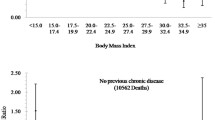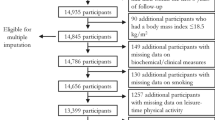Abstract
Objectives: To determine the dose-response relationship between body mass index (BMI) and cause-specific mortality among Canadian adults.
Methods: The sample includes 10,522 adults 18–74 years of age who participated in the Canadian Heart Health Surveys (1986–1995). Participants were divided into 5 BMI categories (<18.5, 18.5–24.9, 25–29.9, 30–34.9, and =35 kg/m2). Multivariate-adjusted (age, sex, exam year, smoking status, alcohol consumption and education) hazard ratios for all-cause, cardiovascular disease (CVD) and cancer mortality were estimated using Cox proportional hazards regression.
Results: There were 1,149 deaths (402 CVD; 412 cancer) over an average of 13.9 years (range 0.5 to 19.1 years), and the analyses are based on 145,865 person-years. The hazard ratios (95% CI) across successive BMI categories for all-cause mortality were 1.25 (0.83–1.90), 1.00 (reference), 1.06 (0.92–1.22), 1.27 (1.07–1.51) and 1.65 (1.29–2.10). The corresponding hazard ratios for CVD mortality were 1.30 (0.60–2.83), 1.00 (reference), 1.57 (1.22–2.01), 1.72 (1.27–2.33) and 2.09 (1.35–3.22); and for cancer, the hazard ratios were 1.02 (0.48–2.21), 1.00 (reference), 1.14 (0.90–1.44), 1.34 (1.01–1.78) and 1.82 (1.22–2.71). There were significant linear trends across BMI categories for all-cause (p=0.0001), CVD (p<0.0001) and cancer mortality (p=0.003).
Conclusions: The results demonstrate significant relationships between BMI and mortality from all causes, CVD and cancer. The increased risk of all-cause, CVD and cancer mortality associated with an elevated BMI was significant at levels above 30 kg/m2; however, overweight individuals (BMI 25–29.9 kg/m2) also had an approximately 60% higher risk of CVD mortality.
Résumé
Objectif: Déterminer la relation dose-réponse entre l’indice de masse corporelle (IMC) et la mortalité par cause chez les Canadiens d’âge adulte.
Méthode: Notre échantillon comprenait 10 522 adultes de 18 à 74 ans ayant participé aux Enquêtes sur la santé cardiovasculaire des Canadiens (1986–1995). Les participants ont été divisés en cinq catégories d’IMC (<18,5, 18,5–24,9, 25–29,9, 30–34,9 et =35 kg/m2). À l’aide du modèle de régression à effet proportionnel de Cox, nous avons estimé des coefficients de danger ajustés selon plusieurs variables (âge, sexe, année d’examen, usage du tabac, consommation d’alcool et niveau d’instruction) pour la mortalité toutes causes confondues, la mortalité par maladie cardiovasculaire (MCV) et la mortalité par cancer.
Résultats: Il y a eu 1 149 décès (402 par MCV; 412 par cancer) sur une moyenne de 13,9 ans (intervalle de 0,5 à 19,1 ans), et les analyses sont basées sur 145 865 personnes-années. Les coefficients de danger (IC de 95 %) par catégorie successive d’IMC pour la mortalité toutes causes confondues étaient de 1,25 (0,83–1,90), 1,00 (référence), 1,06 (0,92–1,22), 1,27 (1,07–1,51) et 1,65 (1,29–2,10). Les coefficients de danger correspondants pour la mortalité par MCV étaient de 1,30 (0,60–2,83), 1,00 (référence), 1,57 (1,22–2,01), 1,72 (1,27–2,33) et 2,09 (1,35–3,22); pour le cancer, ils étaient de 1,02 (0,48–2,21), 1,00 (référence), 1,14 (0,90–1,44), 1,34 (1,01–1,78) et 1,82 (1,22–2,71). Nous avons relevé des tendances linéaires significatives d’une catégorie d’IMC à l’autre pour la mortalité toutes causes confondues (p=0,0001), la mortalité par MCV (p<0,0001) et la mortalité par cancer (p=0,003).
Conclusion: Ces résultats font état de relations significatives entre l’IMC et la mortalité toutes causes confondues, par MCV et par cancer. Dans les trois cas, le risque accru de mortalité associé à un IMC élevé était significatif à plus de 30 kg/m2; cependant, les sujets en surpoids (IMC 25–29,9 kg/m2) avaient aussi un risque plus élevé d’environ 60 % de mourir d’une MCV.
Similar content being viewed by others
References
NIH. Clinical guidelines on the identification, evaluation, and treatment of overweight and obesity in adults—The evidence report. Obes Res 1998;6(Suppl.2):51S–209S [published erratum appears in Obes Res 1998;1996(1996):1464].
Allison DB, Faith MS, Heo M, Kotler DP. Hypothesis concerning the U-shaped relation between body mass index and mortality. Am J Epidemiol 1997;146:339–49.
World Health Organization. Obesity: Preventing and Managing the Global Epidemic. Report of a WHO Consultation on Obesity, Geneva, 3–5 June, 1997. Geneva: World Health Organization, 1998.
NIH. The Practical Guide to the Identification, Evaluation and Treatment of Overweight and Obesity in Adults. Bethesda, MD: US NIH, 2000.
Health Canada. Canadian Guidelines for Body Weight Classification in Adults. Cat. No. H49-179/2003E. Ottawa, ON: Health Canada, 2003.
Lewis CE, McTigue KM, Burke LE, Poirier P, Eckel RH, Howard BV, et al. Mortality, health outcomes, and body mass index in the overweight range: A science advisory from the American Heart Association. Circulation 2009;119(25):3263–71.
Flegal KM, Graubard BI, Williamson DF, Gail MH. Excess deaths associated with underweight, overweight and obesity. JAMA 2005;293:1861–67.
Flegal KM, Graubard BI, Williamson DF, Gail MH. Cause-specific excess deaths associated with underweight, overweight, and obesity. JAMA 2007;298(17):2028–37.
Berrington de Gonzalez A, Hartge P, Cerhan JR, Flint AJ, Hannan L, MacInnis RJ, et al. Body-mass index and mortality among 1.46 million white adults. N Engl J Med 2010;363(23):2211–19.
Jee SH, Sull JW, Park J, Lee SY, Ohrr H, Guallar E, et al. Body-mass index and mortality in Korean men and women. N Engl J Med 2006;355(8):779–87.
Klenk J, Nagel G, Ulmer H, Strasak A, Concin H, Diem G, et al. Body mass index and mortality: Results of a cohort of 184,697 adults in Austria. Eur J Epidemiol 2009;24(2):83–91.
Zheng W, McLerran DF, Rolland B, Zhang X, Inoue M, Matsuo K, et al. Association between body-mass index and risk of death in more than 1 million Asians. N Engl J Med 2011;364(8):719–29.
Jain MG, Miller AB, Rohan TE, Rehm JT, Bondy SJ, Ashley MJ, et al. Body mass index and mortality in women: Follow-up of the Canadian National Breast Screening Study cohort. Int J Obes Relat Metab Disord 2005;29(7):792–97.
Katzmarzyk PT, Craig CL, Bouchard C. Underweight, overweight and obesity: Relationships with mortality in the 13-year follow-up of the Canada Fitness Survey. J Clin Epidemiol 2001;54:916–20.
Orpana HM, Berthelot JM, Kaplan MS, Feeny DH, McFarland B, Ross NA. BMI and mortality: Results from a national longitudinal study of Canadian adults. Obesity (Silver Spring). 2010;18(1):214–18.
MacLean DR, Petrasovits A, Nargundkar M, Connelly PW, Macleod E, Edwards A, et al. Canadian Heart Health Surveys: A profile of cardiovascular risk. Survey methods and data analysis. CMAJ 1992;146(11):1969–74.
Maaten S, Kephart G, Kirkland S, Andreou P. Chronic disease risk factors associated with health service use in the elderly. BMC Health Serv Res 2008;8:237.
Statistics Canada. Vital Statistics — Death Database: Detailed information for 2005. Ottawa, ON: Statistics Canada, 2007. Available at: http://www.statcan.gc.ca/cgi-bin/imdb/p2SV.pl?Function=getSurvey&SurvId=3233&SurvVer=0&InstaId=15306&InstaVer=8&SDDS=3233&lang=en&db=imdb&adm=8&dis=2 (Accessed February 7, 2011).
Schnatter AR, Acquavella JF, Thompson FS, Donaleski D, Theriault G. An analysis of death ascertainment and follow-up through Statistics Canada’s Mortality Database System. Can J Public Health 1990;81:60–65.
Shannon HS, Jamieson E, Walsh C, Julian JA, Fair ME, Buffett A. Comparison of individual follow-up and computerized linkage using the Canadian Mortality Data Base System. Can J Public Health 1989;80:54–57.
SAS Institute. SAS/STAT 9.22 User’s Guide. Cary, NC: SAS Institute Inc., 2010.
Statistics Canada. Health indicators, June 21, 2011. Catalogue # 82-221-XWE. 2011.
Author information
Authors and Affiliations
Corresponding author
Additional information
Acknowledgements: This research was supported by a New Emerging Team grant from the Heart and Stroke Foundation of Canada and the Canadian Institutes of Health Research. PTK is partially supported by the Louisiana Public Facilities Authority Endowed Chair in Nutrition. KR and GP acknowledge salary support from the Applied Public Health Chairs program of the Canadian Institutes of Health Research. KR acknowledges additional funding from the Heart and Stroke Foundation of Canada. Special thanks to Alison Edwards for help with data management; Dr. Stephanie Broyles for help with multiple imputation procedures; and Paula Woollam and Georgia Roberts from Statistics Canada for their contributions to conducting the mortality linkage and assembling the resulting dataset.
Conflict of Interest: None to declare.
Rights and permissions
About this article
Cite this article
Katzmarzyk, P.T., Reeder, B.A., Elliott, S. et al. Body Mass Index and Risk of Cardiovascular Disease, Cancer and All-cause Mortality. Can J Public Health 103, 147–151 (2012). https://doi.org/10.1007/BF03404221
Received:
Accepted:
Published:
Issue Date:
DOI: https://doi.org/10.1007/BF03404221




